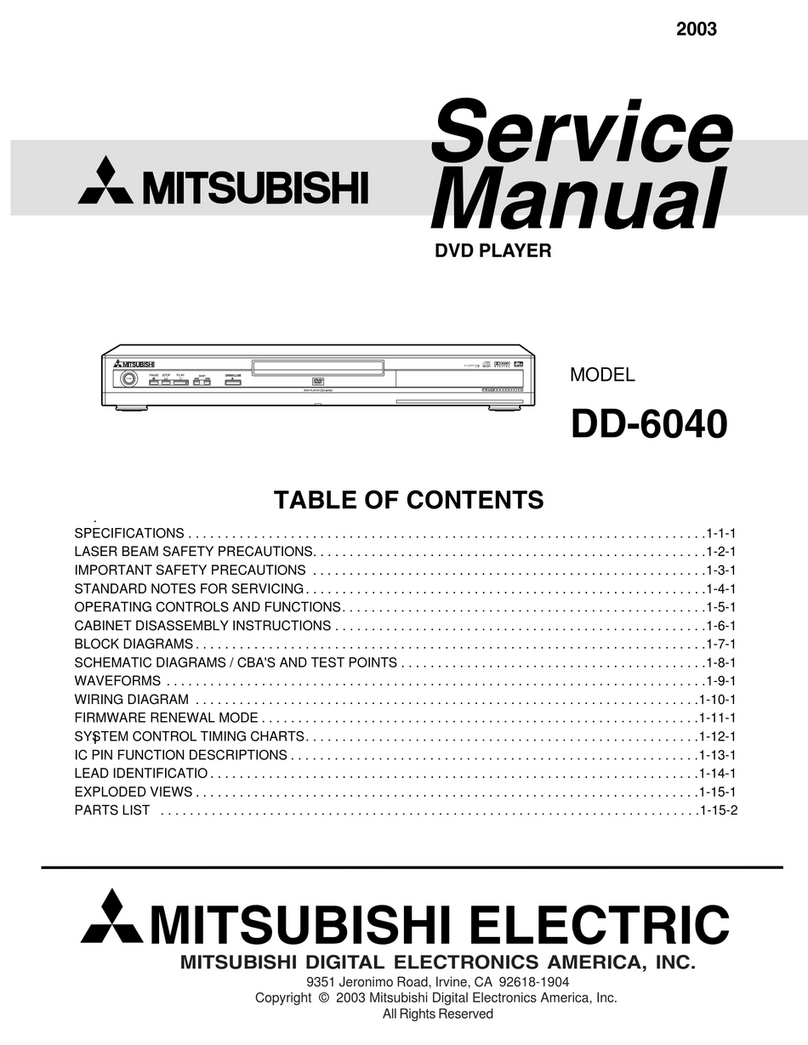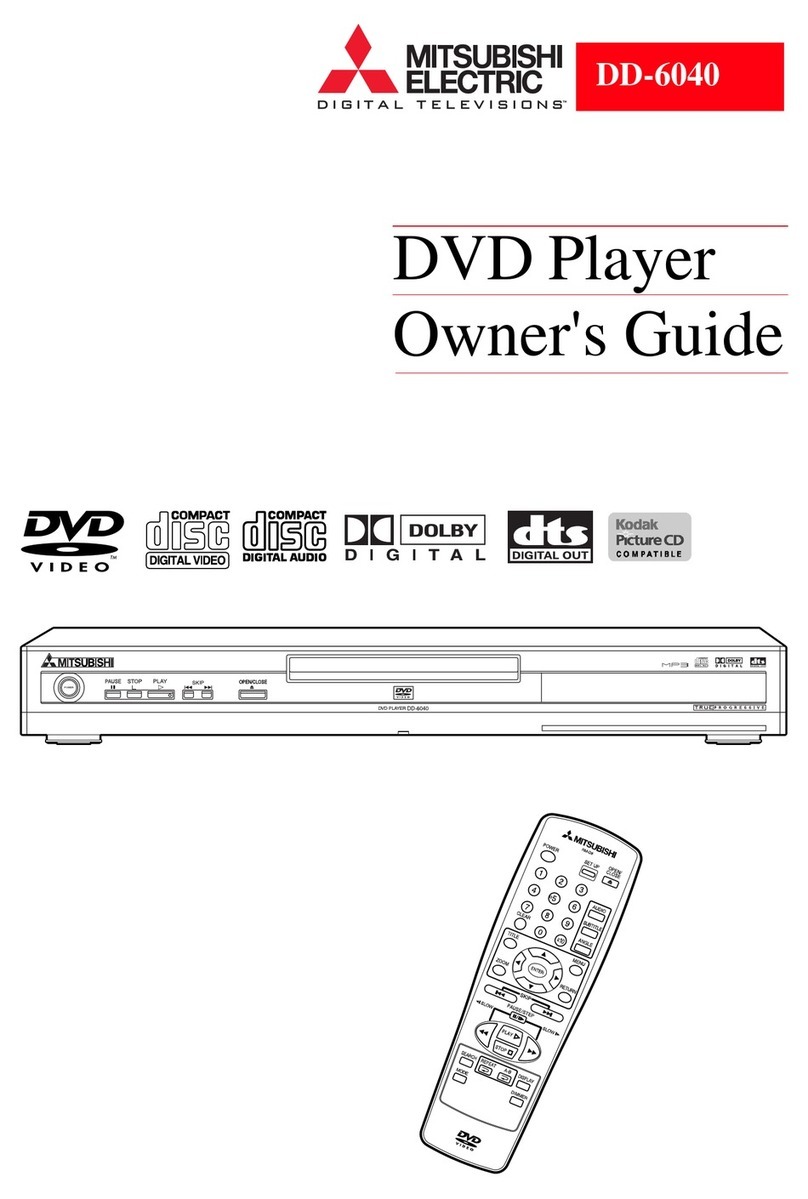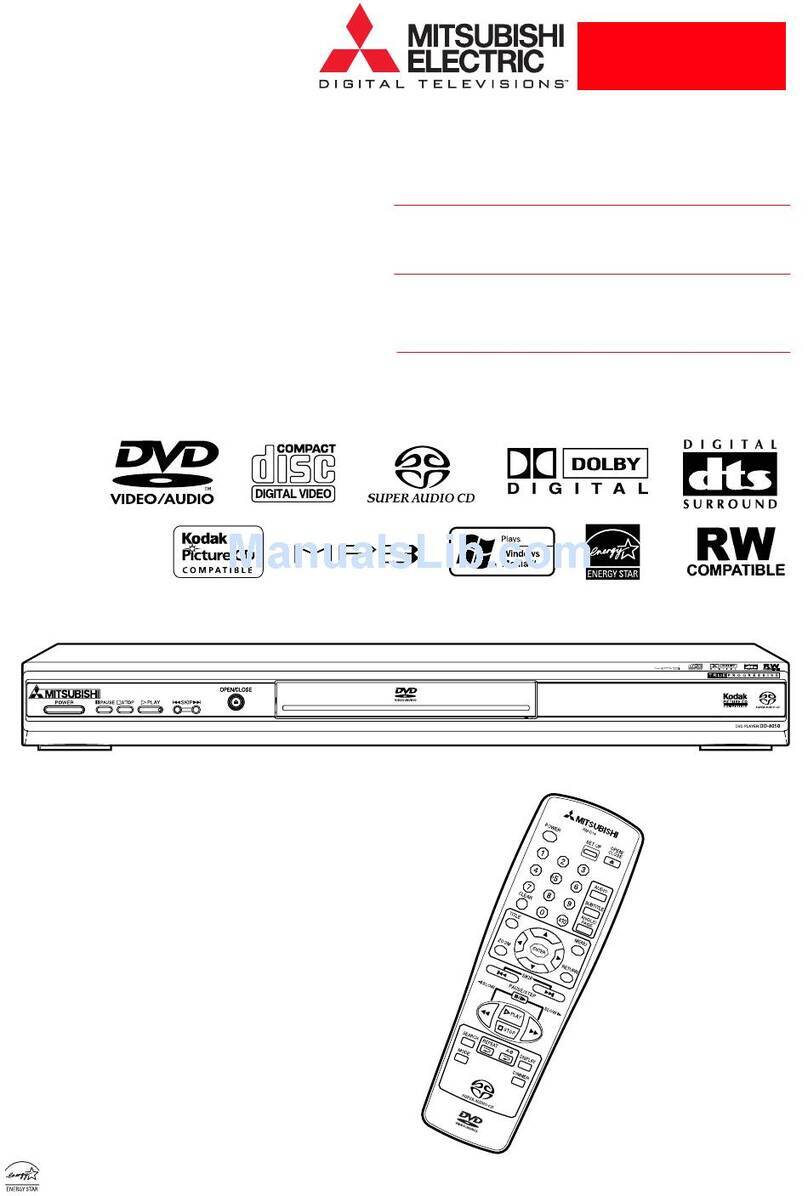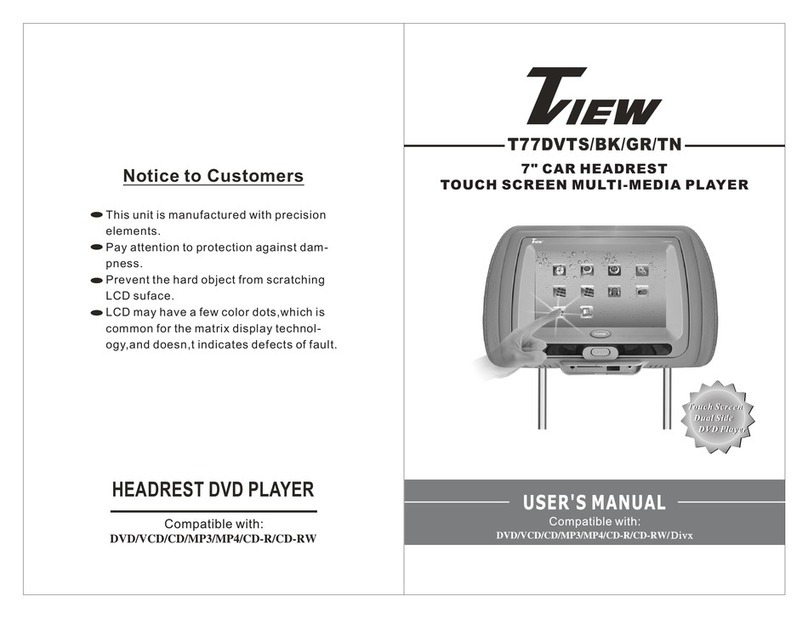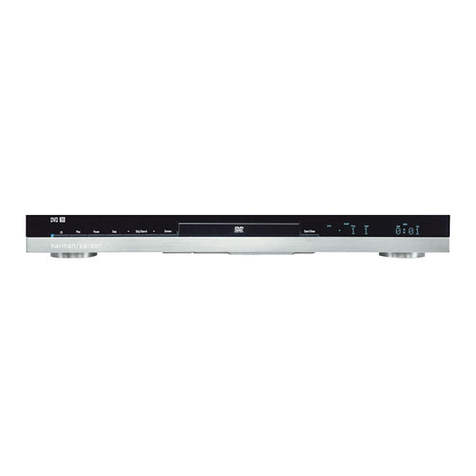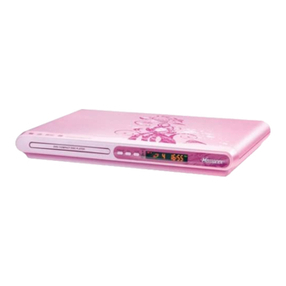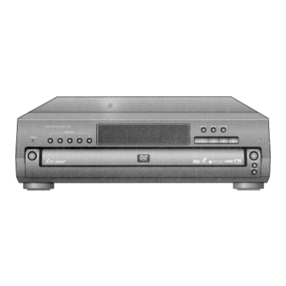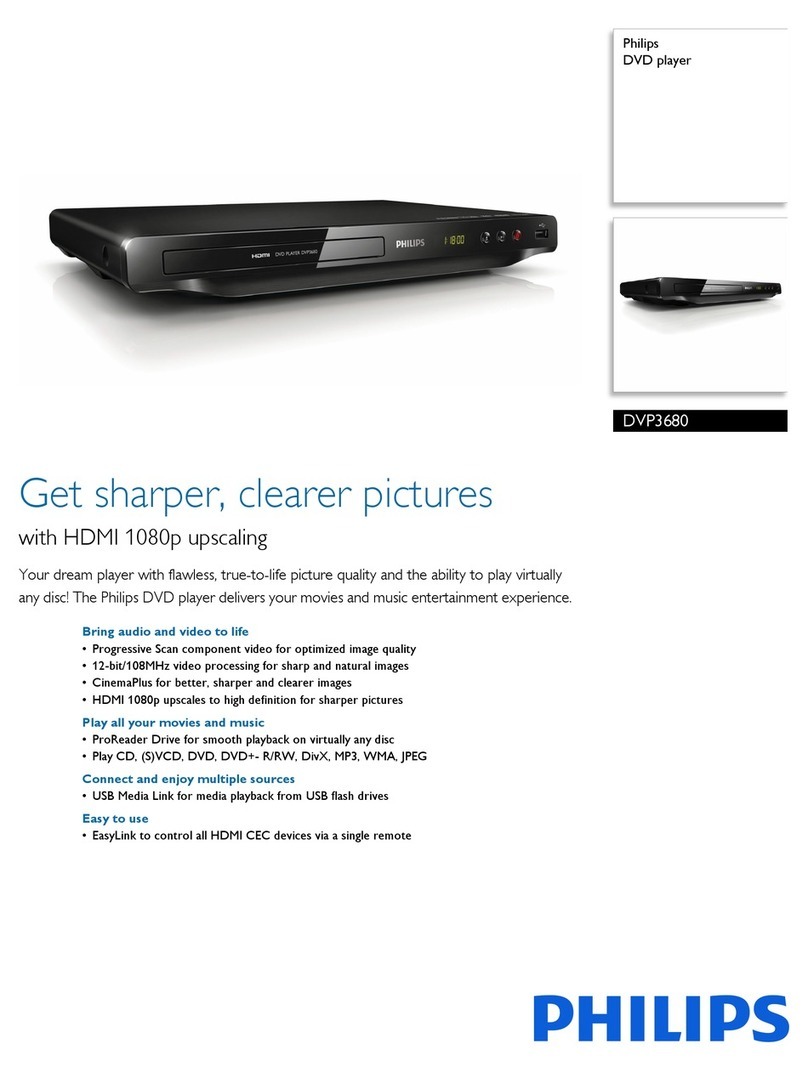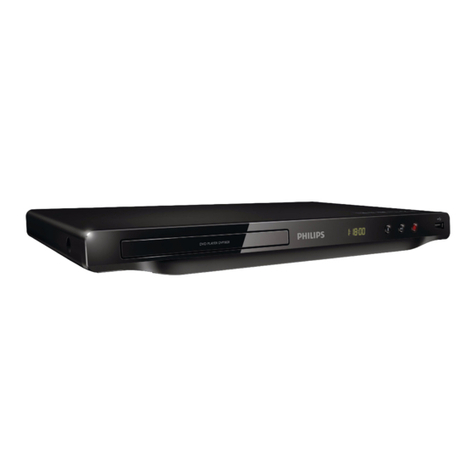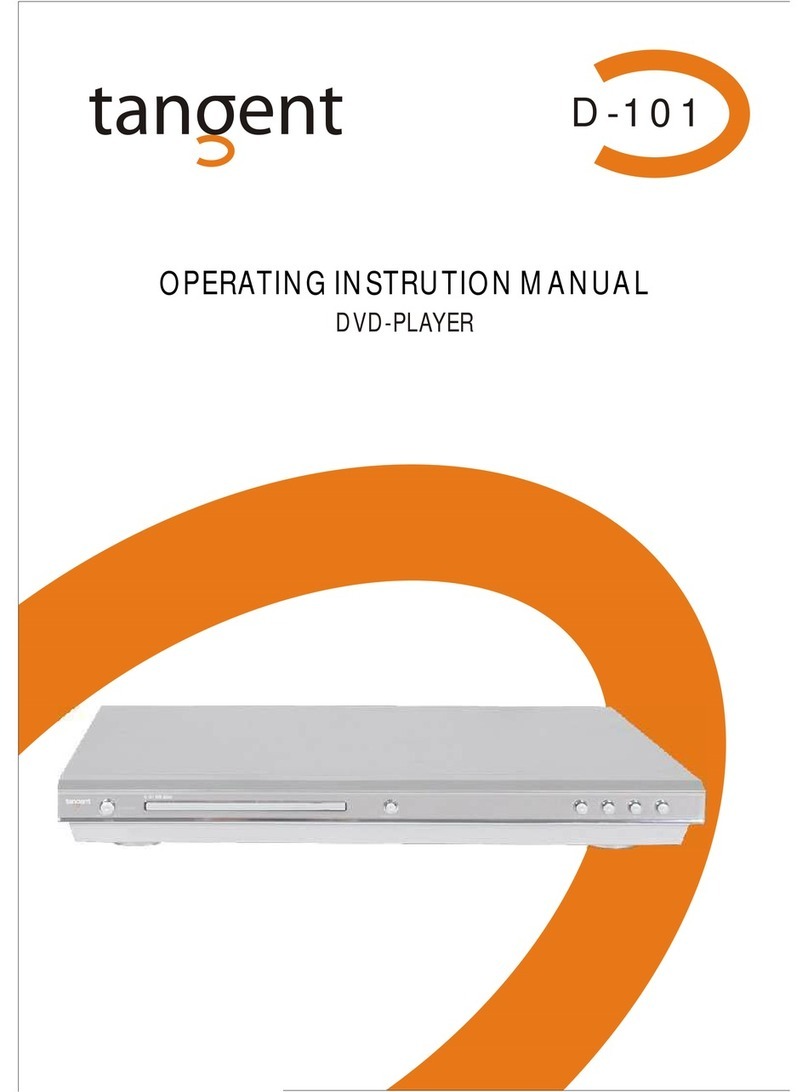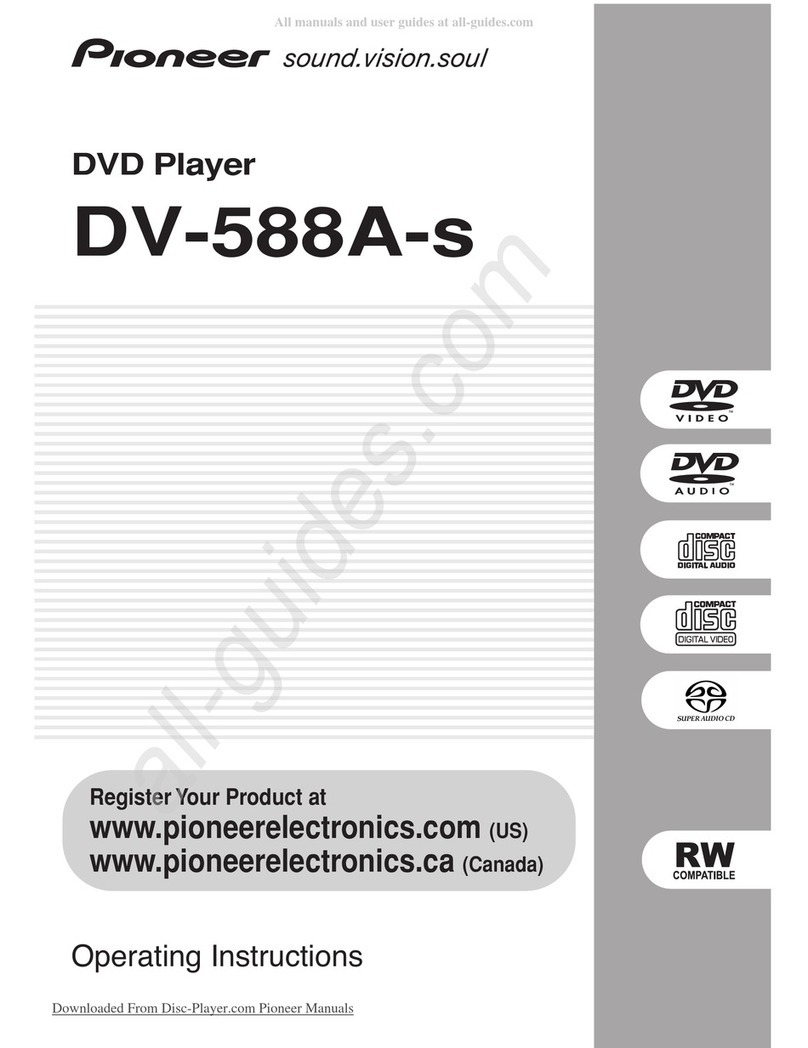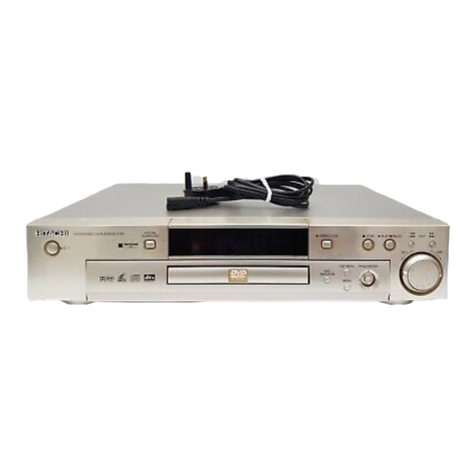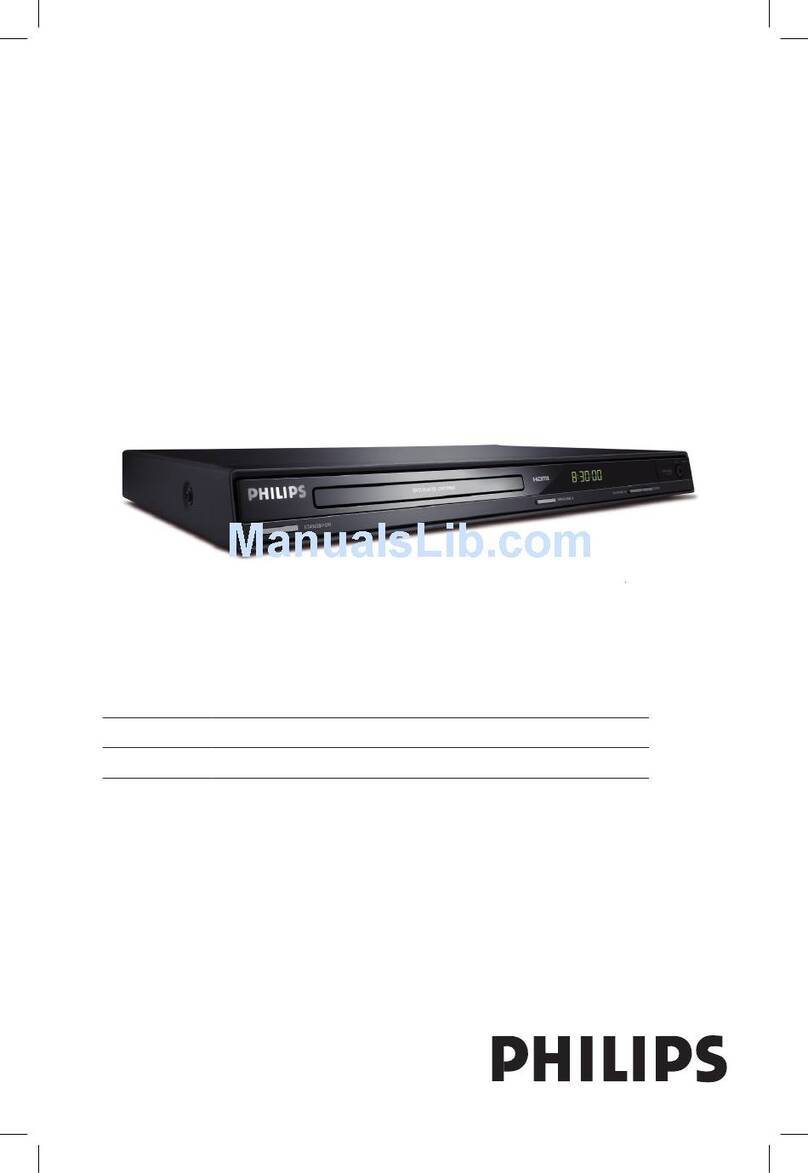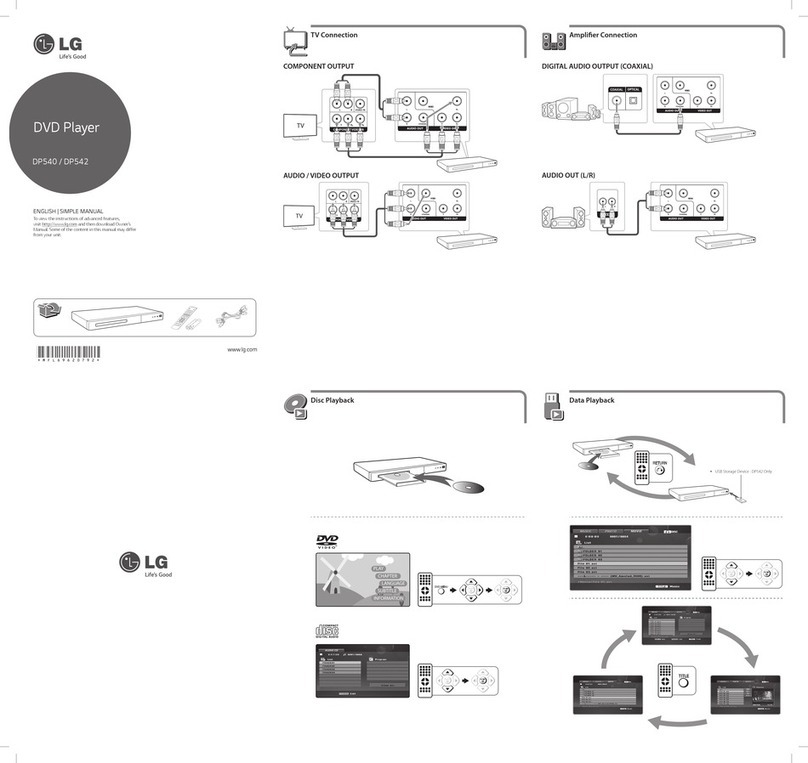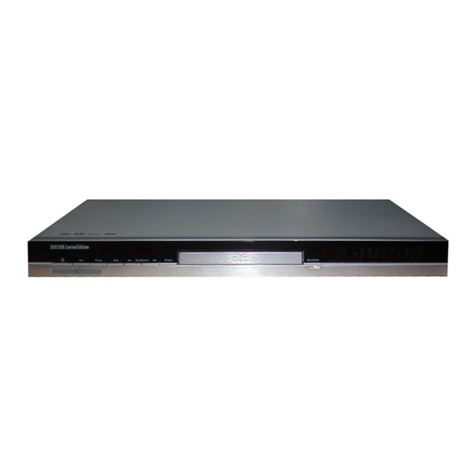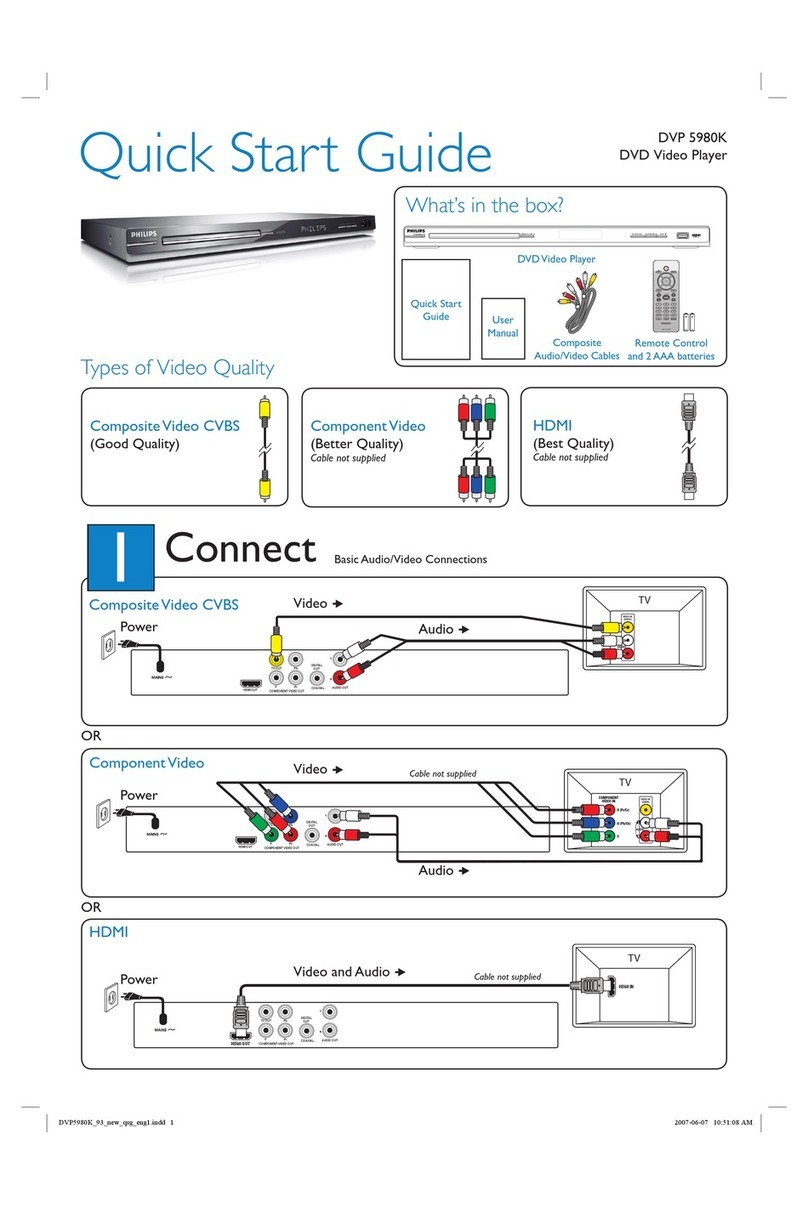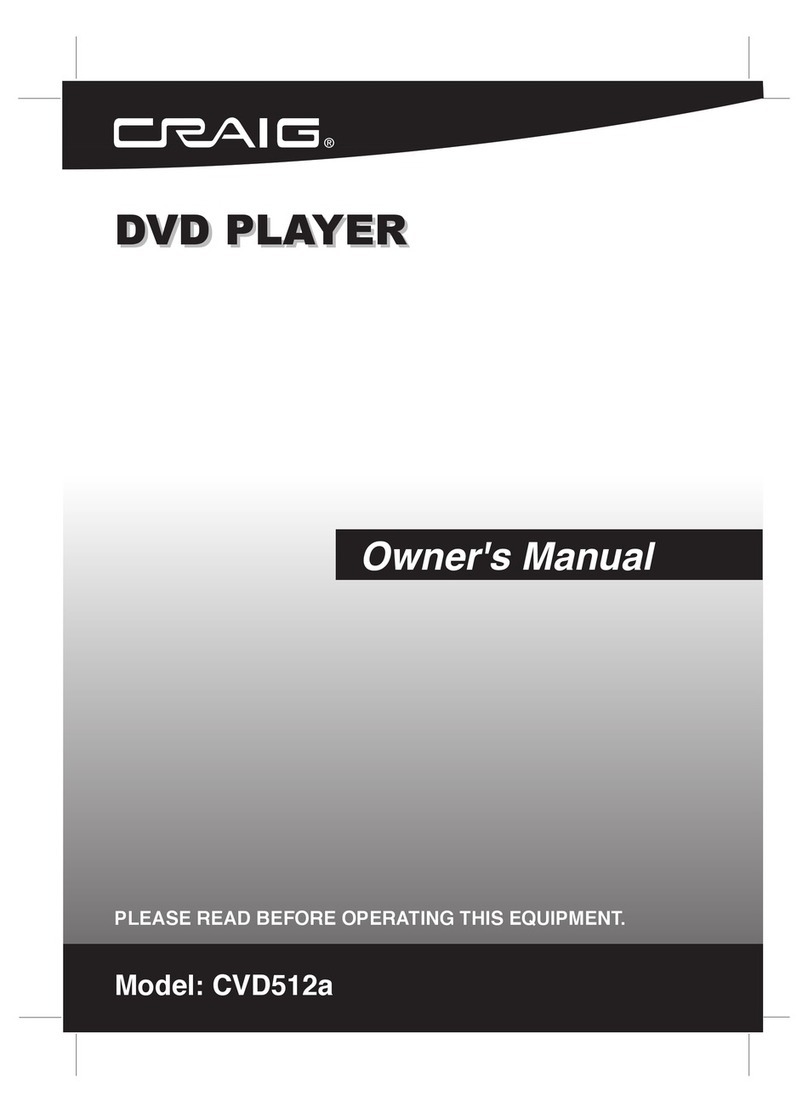Mitsubishi DD-8050 User manual

DVD PLAYER
2004
MODEL
DD-8050
Manual
Service
TABLE OF CONTENTS
SPECIFICATIONS . . . . . . . . . . . . . . . . . . . . . . . . . . . . . . . . . . . . . . . . . . . . . . . . . . . . . . . . . . . . . . . . . . . . . . .1-1-1
LASER BEAM SAFETY PRECAUTIONS. . . . . . . . . . . . . . . . . . . . . . . . . . . . . . . . . . . . . . . . . . . . . . . . . . . . . .1-2-1
IMPORTANT SAFETY PRECAUTIONS . . . . . . . . . . . . . . . . . . . . . . . . . . . . . . . . . . . . . . . . . . . . . . . . . . . . . .1-3-1
STANDARD NOTES FOR SERVICING . . . . . . . . . . . . . . . . . . . . . . . . . . . . . . . . . . . . . . . . . . . . . . . . . . . . . . .1-4-1
OPERATING CONTROLS AND FUNCTIONS. . . . . . . . . . . . . . . . . . . . . . . . . . . . . . . . . . . . . . . . . . . . . . . . . .1-5-1
CABINET DISASSEMBLY INSTRUCTIONS . . . . . . . . . . . . . . . . . . . . . . . . . . . . . . . . . . . . . . . . . . . . . . . . . . .1-6-1
BLOCK DIAGRAMS . . . . . . . . . . . . . . . . . . . . . . . . . . . . . . . . . . . . . . . . . . . . . . . . . . . . . . . . . . . . . . . . . . . . . .1-7-1
SCHEMATIC DIAGRAMS / CBA'S AND TEST POINTS . . . . . . . . . . . . . . . . . . . . . . . . . . . . . . . . . . . . . . . . . .1-8-1
WAVEFORMS . . . . . . . . . . . . . . . . . . . . . . . . . . . . . . . . . . . . . . . . . . . . . . . . . . . . . . . . . . . . . . . . . . . . . . . . . .1-9-1
WIRING DIAGRAM . . . . . . . . . . . . . . . . . . . . . . . . . . . . . . . . . . . . . . . . . . . . . . . . . . . . . . . . . . . . . . . . . . . . .1-10-1
FIRMWARE RENEWAL MODE . . . . . . . . . . . . . . . . . . . . . . . . . . . . . . . . . . . . . . . . . . . . . . . . . . . . . . . . . . . .1-11-1
SYSTEM CONTROL TIMING CHARTS. . . . . . . . . . . . . . . . . . . . . . . . . . . . . . . . . . . . . . . . . . . . . . . . . . . . . .1-12-1
IC PIN FUNCTION DESCRIPTIONS . . . . . . . . . . . . . . . . . . . . . . . . . . . . . . . . . . . . . . . . . . . . . . . . . . . . . . . .1-13-1
LEAD IDENTIFICATIONS . . . . . . . . . . . . . . . . . . . . . . . . . . . . . . . . . . . . . . . . . . . . . . . . . . . . . . . . . . . . . . . .1-14-1
EXPLODED VIEWS . . . . . . . . . . . . . . . . . . . . . . . . . . . . . . . . . . . . . . . . . . . . . . . . . . . . . . . . . . . . . . . . . . . . .1-15-1
MECHANICAL PARTS LIST . . . . . . . . . . . . . . . . . . . . . . . . . . . . . . . . . . . . . . . . . . . . . . . . . . . . . . . . . . . . . .1-16-1
ELECTRICAL PARTS LIST . . . . . . . . . . . . . . . . . . . . . . . . . . . . . . . . . . . . . . . . . . . . . . . . . . . . . . . . . . . . . . .1-17-1
MITSUBISHI ELECTRIC
MITSUBISHI DIGITAL ELECTRONICS AMERICA, INC.
9351 Jeronimo Road, Irvine, CA 92618-1904
Copyright © 2003 Mitsubishi Digital Electronics America, Inc.
AllRightsReserved

Manufactured under license from Dolby Laboratories. "Dolby"
and the double-D symbol are trademarks of Dolby Laboratories.

1-1-1 E5932SP
SPECIFICATIONS
NOTES:
1. All Items are measured without pre-emphasis unless otherwise specified.
2. Power supply : AC120 V 60 Hz
3. Load imp. : 100 k ohm
4. Ambient Temperature : +25 °C
ITEM CONDITIONS UNIT NOMINAL LIMIT
1. Video Output 75 ohm load Vpp 1.0 ± 0.1
2. Optical Digital Out dBm -18
3. Audio (PCM)
3-1. Output Level 1 kHz 0 dB Vrms 2.0
3-2. S/N dB 120
3-3. Freq. Response
DVD fs=48kHz ± 0.5dB Hz 20~22 k
CD fs=44.1kHz ± 0.5dB Hz 20~20 k
3-4. THD+N
DVD 1 kHz 0dB % 0.004
CD 1 kHz 0dB % 0.0045

1-2-1 E5_LASER
Drive Mecha Assembly
Laser Beam Radiation
Laser Pickup
Turntable
LASER RADIATION
WHEN OPEN. DO NOT
STARE INTO BEAM.
CAUTION
LASER BEAM SAFETY PRECAUTIONS
This DVD player uses a pickup that emits a laser beam.
The laser beam is emitted from the location shown in the figure. When checking the laser diode, be sure to keep
your eyes at least 30cm away from the pickup lens when the diode is turned on. Do not look directly at the laser
beam.
Caution: Use of controls and adjustments, or doing procedures other than those specified herein, may result in
hazardous radiation exposure.
Do not look directly at the laser beam coming
from the pickup or allow it to strike against your
skin.
Location: Top of DVD mechanism.

1-3-1 DVD_SFN1
IMPORTANT SAFETY PRECAUTIONS
Product Safety Notice
Some electrical and mechanical parts have special
safety-related characteristics which are often not evi-
dent from visual inspection, nor can the protection they
give necessarily be obtained by replacing them with
components rated for higher voltage, wattage, etc.
Parts that have special safety characteristics are iden-
tified by a #on schematics and in parts lists. Use of a
substitute replacement that does not have the same
safety characteristics as the recommended replace-
ment part might create shock, fire, and/or other haz-
ards. The Product’s Safety is under review
continuously and new instructions are issued when-
ever appropriate. Prior to shipment from the factory,
our products are carefully inspected to confirm with
the recognized product safety and electrical codes of
the countries in which they are to be sold. However, in
order to maintain such compliance, it is equally impor-
tant to implement the following precautions when a set
is being serviced.
Precautions during Servicing
A. Parts identified by the #symbol are critical for
safety. Replace only with part number specified.
B. In addition to safety, other parts and assemblies
are specified for conformance with regulations
applying to spurious radiation. These must also be
replaced only with specified replacements.
Examples: RF converters, RF cables, noise block-
ing capacitors, and noise blocking filters, etc.
C. Use specified internal wiring. Note especially:
1)Wires covered with PVC tubing
2)Double insulated wires
3)High voltage leads
D. Use specified insulating materials for hazardous
live parts. Note especially:
1)Insulation tape
2)PVC tubing
3)Spacers
4)Insulators for transistors
E. When replacing AC primary side components
(transformers, power cord, etc.), wrap ends of
wires securely about the terminals before solder-
ing.
F. Observe that the wires do not contact heat produc-
ing parts (heatsinks, oxide metal film resistors, fus-
ible resistors, etc.).
G. Check that replaced wires do not contact sharp
edges or pointed parts.
H. When a power cord has been replaced, check that
5 - 6 kg of force in any direction will not loosen it.
I. Also check areas surrounding repaired locations.
J. Be careful that foreign objects (screws, solder
droplets, etc.) do not remain inside the set.
K. Crimp type wire connector
The power transformer uses crimp type connectors
which connect the power cord and the primary side
of the transformer. When replacing the transformer,
follow these steps carefully and precisely to prevent
shock hazards.
Replacement procedure
1)Remove the old connector by cutting the wires at a
point close to the connector.
Important: Do not re-use a connector. (Discard it.)
2)Strip about 15 mm of the insulation from the ends
of the wires. If the wires are stranded, twist the
strands to avoid frayed conductors.
3)Align the lengths of the wires to be connected.
Insert the wires fully into the connector.
4)Use a crimping tool to crimp the metal sleeve at its
center. Be sure to crimp fully to the complete clo-
sure of the tool.
L. When connecting or disconnecting the internal
connectors, first, disconnect the AC plug from the
AC outlet.

1-3-2 DVD_SFN1
Chassis or Secondary Conductor
dd'
Primary Circuit Terminals
AC Voltmeter
(High Impedance)
Exposed Accessible Part
BEarth Ground
Power Cord Plug Prongs
Z
1.5k 0.15 F
Safety Check after Servicing
Examine the area surrounding the repaired location for
damage or deterioration. Observe that screws, parts,
and wires have been returned to their original posi-
tions. Afterwards, do the following tests and confirm
the specified values to verify compliance with safety
standards.
1. Clearance Distance
When replacing primary circuit components, confirm
specified clearance distance (d) and (d’) between sol-
dered terminals, and between terminals and surround-
ing metallic parts. (See Fig. 1)
Table 1: Ratings for selected area
Note: This table is unofficial and for reference only.
Be sure to confirm the precise values.
2. Leakage Current Test
Confirm the specified (or lower) leakage current
between B (earth ground, power cord plug prongs)
and externally exposed accessible parts (RF termi-
nals, antenna terminals, video and audio input and
output terminals, microphone jacks, earphone jacks,
etc.) is lower than or equal to the specified value in the
table below.
Measuring Method (Power ON) :
Insert load Z between B (earth ground, power cord
plug prongs) and exposed accessible parts. Use an
AC voltmeter to measure across the terminals of load
Z. See Fig. 2 and the following table.
AC Line Voltage Clearance Distance (d), (d’)
120 V ≥3.2mm (0.126 inches)
Table 2: Leakage current ratings for selected areas
Note: This table is unofficial and for reference only. Be sure to confirm the precise values.
AC Line Voltage Load Z Leakage Current (i) Earth Ground (B) to:
120 V 0.15µF CAP. & 1.5kΩ RES.
Connected in parallel i≤0.5mA Peak Exposed accessible parts
Fig. 1
Fig. 2

1-4-1 E5STA
STANDARD NOTES FOR SERVICING
Circuit Board Indications
1. The output pin of the 3 pin Regulator ICs is indi-
cated as shown.
2. For other ICs, pin 1 and every fifth pin are indicated
as shown.
3. The 1st pin of every male connector is indicated as
shown.
Instructions for Connectors
1. When you connect or disconnect the FFC (Flexible
Foil Connector) cable, be sure to first disconnect
the AC cord.
2. FFC (Flexible Foil Connector) cable should be
inserted parallel into the connector, not at an angle.
Pb (Lead) Free Solder
When soldering, be sure to use the Pb free solder.
How to Remove / Install Flat Pack-IC
1. Removal
With Hot-Air Flat Pack-IC Desoldering Machine:.
(1) Prepare the hot-air flat pack-IC desoldering
machine, then apply hot air to the Flat Pack-IC
(about 5 to 6 seconds). (Fig. S-1-1)
(2) Remove the flat pack-IC with tweezers while apply-
ing the hot air.
(3) Bottom of the flat pack-IC is fixed with glue to the
CBA; when removing entire flat pack-IC, first apply
soldering iron to center of the flat pack-IC and heat
up. Then remove (glue will be melted). (Fig. S-1-6)
(4) Release the flat pack-IC from the CBA using twee-
zers. (Fig. S-1-6)
Caution:
1. The Flat Pack-IC shape may differ by models. Use
an appropriate hot-air flat pack-IC desoldering
machine, whose shape matches that of the Flat
Pack-IC.
2. Do not supply hot air to the chip parts around the
flat pack-IC for over 6 seconds because damage to
the chip parts may occur. Put masking tape around
the flat pack-IC to protect other parts from damage.
(Fig. S-1-2)
Top View
Out In
Bottom View
Input
5
10
Pin 1
Pin 1
FFC Cable
Connector
CBA
* Be careful to avoid a short circuit.
Fig. S-1-1

1-4-2 E5STA
3. The flat pack-IC on the CBA is affixed with glue, so
be careful not to break or damage the foil of each
pin or the solder lands under the IC when removing
it.
With Soldering Iron:
(1) Using desoldering braid, remove the solder from all
pins of the flat pack-IC. When you use solder flux
which is applied to all pins of the flat pack-IC, you
can remove it easily. (Fig. S-1-3)
(2) Lift each lead of the flat pack-IC upward one by
one, using a sharp pin or wire to which solder will
not adhere (iron wire). When heating the pins, use
a fine tip soldering iron or a hot air desoldering
machine. (Fig. S-1-4)
(3) Bottom of the flat pack-IC is fixed with glue to the
CBA; when removing entire flat pack-IC, first apply
soldering iron to center of the flat pack-IC and heat
up. Then remove (glue will be melted). (Fig. S-1-6)
(4) Release the flat pack-IC from the CBA using twee-
zers. (Fig. S-1-6)
Fig. S-1-2
Hot-air
Flat Pack-IC
Desoldering
Machine
CBA
Flat Pack-IC
Tweezers
Masking
Tape Fig. S-1-3
Flat Pack-IC Desoldering Braid
Soldering Iron
Fig. S-1-4
Fine Tip
Soldering Iron
Sharp
Pin

1-4-3 E5STA
With Iron Wire:
(1) Using desoldering braid, remove the solder from all
pins of the flat pack-IC. When you use solder flux
which is applied to all pins of the flat pack-IC, you
can remove it easily. (Fig. S-1-3)
(2) Affix the wire to a workbench or solid mounting
point, as shown in Fig. S-1-5.
(3) While heating the pins using a fine tip soldering
iron or hot air blower, pull up the wire as the solder
melts so as to lift the IC leads from the CBA contact
pads as shown in Fig. S-1-5.
(4) Bottom of the flat pack-IC is fixed with glue to the
CBA; when removing entire flat pack-IC, first apply
soldering iron to center of the flat pack-IC and heat
up. Then remove (glue will be melted). (Fig. S-1-6)
(5) Release the flat pack-IC from the CBA using twee-
zers. (Fig. S-1-6)
Note:
When using a soldering iron, care must be taken
to ensure that the flat pack-IC is not being held by
glue. When the flat pack-IC is removed from the
CBA, handle it gently because it may be damaged
if force is applied.
2. Installation
(1) Using desoldering braid, remove the solder from
the foil of each pin of the flat pack-IC on the CBA so
you can install a replacement flat pack-IC more
easily.
(2) The “I” mark on the flat pack-IC indicates pin 1.
(See Fig. S-1-7.) Be sure this mark matches the 1
on the PCB when positioning for installation. Then
presolder the four corners of the flat pack-IC. (See
Fig. S-1-8.)
(3) Solder all pins of the flat pack-IC. Be sure that none
of the pins have solder bridges.
Fig. S-1-5
To Solid
Mounting Point
Soldering Iron
Iron Wire
or
Hot Air Blower
Fig. S-1-6
Fine Tip
Soldering Iron
CBA
Flat Pack-IC
Tweezers
Fig. S-1-7
Example :
Pin 1 of the Flat Pack-IC
is indicated by a " " mark.
Fig. S-1-8
Presolder
CBA
Flat Pack-IC

1-4-4 E5STA
Instructions for Handling
Semi-conductors
Electrostatic breakdown of the semi-conductors may
occur due to a potential difference caused by electro-
static charge during unpacking or repair work.
1. Ground for Human Body
Be sure to wear a grounding band (1MΩ) that is prop-
erly grounded to remove any static electricity that may
be charged on the body.
2. Ground for Workbench
(1) Be sure to place a conductive sheet or copper plate
with proper grounding (1MΩ) on the workbench or
other surface, where the semi-conductors are to be
placed. Because the static electricity charge on
clothing will not escape through the body ground-
ing band, be careful to avoid contacting semi-con-
ductors with your clothing.
<Incorrect>
CBA
Grounding Band
Conductive Sheet or
Copper Plate
1MΩ
1MΩ
<Correct>
CBA

1-5-1 E5932IB
OPERATING CONTROLS AND FUNCTIONS
®
4 5 6 7 8321
FRONT PANEL
REMOTE CONTROL
1
9
10
6
11
28
13
27
26
14
18
16
17
15
25
12 24
23
5
2
4
22
3
21
20
19
1. POWER Button
Press to turn the power on and off.
2. PAUSE Button (main unit)
Pauses the current disc operation.
PAUSE/STEP Button (remote control)
Pauses the current disc operation. View the still
picture frame by frame.
3. STOP Button
Stops operation of the disc.
4. PLAY Button
Starts playback of the disc contents.
5. SKIP Buttons
: Plays back from the beginning of the next
chapter or track.
:Plays back from the beginning of the current
chapter or track.
6. OPEN/CLOSE Button
Press to insert or remove discs from the tray.
7. Disc loading tray
8. Display, Remote Sensor Window
9. Numeric Buttons
10. CLEAR Button
Resets a setting.
11. TITLE Button
Displays the title menu.
12. Arrow Buttons
Use to scroll and cycle through disc and player men
us
and settings.
13. ENTER Button
Press to accept a setting.
14. ZOOM Button
Enlarges part of a DVD-reproduced image.
15. REV Button
Fast reverse playback to a desired point.
16. SEARCH MODE Button
Press to locate a desired point.
17. REPEAT Button
Repeats playback of the current disc, title, chapter
or
track.
18. MODE Button
Activates program playback or random playback mo
de
when playing DVD-Audio, CDs, Super Audio CDs
or
MP3/JPEG/Picture CD/WMA. Also Sets Image Quali
ty
setting, Black Level, Virtual Surround and Speech Contr
ol.
19. DIMMER Button
Select the display panel brightness.
20. A-B REPEAT Button
Repeats playback of a selected section.
21. DISPLAY Button
Displays timer and bit-rate information on the T
V
screen.
22. FWD Button
Fast forwards playback to a desired point.
23. RETURN Button
Returns to the previous operation.
24. MENU Button
Displays the disc menus.
25. ANGLE/PAGE Buttons
Press to change the camera angle to see the sequen
ce
being played back from a different angle.
Press to select the image to be displayed.
26. SUBTITLE Button
Press to select a desired subtitle language.
27. AUDIO Button
Press to select a desired audio language or sound mod
e.
28. SETUP Button
Press to enter the setup mode or to change setup item
s.

1-5-2 E5932IB
VIDEO OUT
OPTICAL COAXIAL
R
LYCr
VIDEO S-VIDEO
OUT
Cb
CENTER
SUBWOOFER
L
R
SURROUND
R
FRONT
L
ANALOG
5.1 CH
AUDIO OUT
AUDIO OUT
DIGITAL AUDIO OUT
(PCM/BITSTREAM)
29 34 36353330 3132 37
REAR VIEW
2
9. Power Cord
3
0. Left AUDIO OUT Jack
3
1. OPTICAL DIGITAL AUDIO OUT Jack
3
2. COAXIAL DIGITAL AUDIO OUT Jack
3
3. Right AUDIO OUT Jack
34. VIDEO OUT Jack
35. COMPONENT VIDEO OUT Jacks
36. S-VIDEO OUT Jack
37. ANALOG 5.1 CH AUDIO OUT Jacks
DISPLAY DISPLAYS DURING
OPERATION
LOADING THE BATTERIES
GROUP
SACD
P.SCAN
DVD A
VCD
M
Lights up when the A-B repeat function is on.
Lights up when the repeat function is on.
Lights up when
Progressive Scan is on.
Lights up when
playing a Super Audio CD.
Lights up when the ALL repeat function is on.
Lights up when the inserted
disc comes to a pause.
Lights up when playing MULTI-CH AREA
on Super Audio CD.
Displays a type of the disc
which is inserted on the tray.
: DVD disc
DVD
: DVD-audio
: VCD
:
Audio CD, MP3, JPEG, PictureCD, WMA
Lights up when the inserted
disc is being played back.
Lights up when the playback is
slow mode.
Displays how long the current
title or track has been played back.
When a chapter or track is
switched, the number of a new
title, chapter or track is displayed.
Power on
No disc inserted or playing DVD menu
Opening the Tray
Closing the Tray
Loading the disc
Lights up when the playback control is
activated (VCD)
Power off
1. Open the battery compartment cover.
2. Insert two AA batteries, with each one
oriented correctly.
3. Close the cover.
Notes
Do not mix alkaline and manganese batteries.
Do not mix old and new batteries.
It is possible to change the brightness of display unit
by pressing the DIMMER button of remote control
.
the power supply is turned off,
the display is returned to the setup status.
Dark
OFF
Bright
DVD
DVD
DVD
VCD
CD
When

1-6-1 E5932DC
CABINET DISASSEMBLY INSTRUCTIONS
1. Disassembly Flowchart
This flowchart indicates the disassembly steps to gain
access to item(s) to be serviced. When reassembling,
follow the steps in reverse order. Bend, route, and
dress the cables as they were originally.
2. Disassembly Method
(1): Identification (location) No. of parts in the figures
(2): Name of the part
(3): Figure Number for reference
(4): Identification of parts to be removed, unhooked,
unlocked, released, unplugged, unclamped, or
desoldered.
P=Spring, L=Locking Tab, S=Screw,
CN=Connector
*=Unhook, Unlock, Release, Unplug, or Desolder
e.g. 2(S-2) = two Screws (S-2),
2(L-2) = two Locking Tabs (L-2)
(5): Refer to “Reference Notes.”
About tightening screws
When tightening screws, tighten them with the follow-
ing torque.
Reference Notes
CAUTION 1: Locking Tabs (L-1), (L-2) and (L-3) are
fragile. Be careful not to break them.
1-1. Release four Locking Tabs (L-1) and three Lock-
ing Tabs (L-2).
1-2. Release three Locking Tabs (L-3), then remove
the Front Assembly.
CAUTION 2: Electrostatic breakdown of the laser
diode in the optical system block may occur as a
potential difference caused by electrostatic charge
accumulated on cloth, human body etc, during
unpacking or repair work.
To avoid damage of pickup follow next procedures.
2-1. Short the three short lands of FPC cable with sol-
der before removing the FFC cable (CN201) from
it. If you disconnect the FFC cable (CN201), the
laser diode of pickup will be destroyed. (Fig. D4)
2-2. Remove Screw (S-3A) and two Screws (S-3B).
Then disconnect Connectors (CN301), (CN401),
(CN501) and (CN601) and lift the DVD Main CBA
Unit. (Fig. D3)
CAUTION 3: When reassembling, confirm the FFC
cable (CN201) is connected completely. Then remove
the solder from the three short lands of FPC cable.
(Fig. D3)
ID/
LOC.
No.
PART
REMOVAL
Fig.
No.
REMOVE/*UNHOOK/
UNLOCK/RELEASE/
UNPLUG/DESOLDER
Note
[1] Top Case D1 5(S-1) ---
[2] Front
Assembly D2 *4(L-1), *3(L-2),
*3(L-3)
1
1-1
1-2
[3] Reinforce
Plate D2 2(S-2) ---
[4] DVD Main
CBA Unit D3
(S-3A), 2(S-3B),
*CN201, *CN301,
*CN401, *CN501,
*CN601
2
2-1
2-1
3
[5] Rear Panel D4 7(S-4), (S-5) ---
[6] Function
CBA D5 *CN2001 ---
[7] AV CBA D5 (S-6), (S-7), *CN1301 ---
[8] DVD
Mecha D6 4(S-8) ---
[9] Main PCB
Holder D6 2(S-9) ---
[10] 5.1ch Amp
CBA D6 *2(L-4) ---
[11] Jack PCB
Holder D6 2(S-10) ---
↓
(1) ↓
(2) ↓
(3) ↓
(4) ↓
(5)
[1] Top Case
[2] Front
Assembly
[3] Reinforce
Plate
[4] DVD Main
CBA Unit
[5] Rear
Panel
[6] Function
CBA
[7] AV CBA
[8] DVD
Mecha
[9] Main
PCB Holder
[10] 5.1ch
Amp CBA
[11] Jack
PCB Holder
Screws Torque
(S-1), (S-2), (S-3A),
(S-4), (S-5), (S-6),
(S-7), (S-8), (S-9),
(S-10)
0.45 ± 0.05 N·m
(S-3B) 0.38 ± 0.04 N·m

1-6-2 E5932DC
(S-1)
(S-1)
(S-1)
Fig. D1
[1] Top Case
Fig. D2
[2] Front Assembly
(L-2)
(L-3)
(L-1)
(L-1)
(L-1)
(S-2)
[3] Reinforce Plate
[4] DVD Main
CBA Unit
(S-3B)
(S-3B)
(S-3A)
CN201
CN301
CN501
CN401
CN601
A
Short the three short lands by soldering.
(Either of two places.)
Connector
View for A
Fig. D3
Fig. D4
[5] Rear Panel
(S-4)
(S-4)
(S-5)

1-6-3 E5932DC
Fig. D5
[7] AV CBA
[6] Function CBA
(S-6) (S-7)
CN2001
CN1301
Fig. D6
(S-8)
(S-10)
(L-4)
(L-4)
(S-8)
(S-9)
[11] Jack
PCB
Holder
[9] Main
PCB
Holder
[10] 5.1ch Amp CBA
[8] DVD
Mecha
A
View for A
Rotate this roulette in
the direction of the arrow
HOW TO EJECT MANUALLY (Method 1)
1. Remove the Top Case, Reinforce Plate and DVD Main CBA Unit.
2. Rotate the roulette in the direction of the arrow as shown below.

1-6-4 E5932DC
B
View for B
Turn the shaft along with
the opening clockwise.
Rear
Front
Opening
Shaft
(e.g. screwdriver)
HOW TO EJECT MANUALLY (Method 2)
1. Turn the unit over.
2. Insert the shaft less than a diameter of 3 mm (e.g. screw-
driver) straightly into the opening as shown.
3. Turn the shaft along with the opening clockwise.
4. Repeat steps 2 and 3 until the tray will open.
5. Pull the tray slowly with a hand.

1-7-1
BLOCK DIAGRAMS
System Control / Servo Block Diagram
E5932BLS
IC301
(SERVO DRIVE)
CN301
M
SLED
MOTOR
M
SPINDLE
MOTOR
FG
SENSOR
IC101
(MICRO CONTROLLER)
+
-
+
-
+
-
+
-
+
-
+
-
+
-
SLED
MOTOR
DRIVE
FOCUS
ACTUATOR
DRIVE
SPINDLE
MOTOR
DRIVE
TRACKING
ACTUATOR
DRIVE
147
TRAY-IN
SLD
75
SPDL
76
TRACKING
DRIVE
148
FOCUS DRIVE
66
FS(+)
FS(-)
TS(+)
TS(-)
57
ADAC-MD
56 ADAC-MC
86 ADAC-ML
ADAC-MC
ADAC-MD
ADAC-MC
ADAC-ML
53
A-MUTE
ADAC-MD
A-MUTE
77 M-MUTE
M-MUTE
TRAY-IN
3SP(+)
4SP(-)
5TRAY-IN
6GND
7SL(-)
8SL(+)
1FG-IN
VREF
RESET73
RESET
IC462
1 3
+3.3V
IC202
(OP AMP)
15
16
14
13
12
11
17
18 23
6
4
5
3
1
2
25
24
27
26
81 SL-AMP
72 FG-IN
143
SP-ROT
+3.3V
146
FD-OFST
139
TD-OFST
RESET
IC461
2 1
+3.3V
TO DIGITAL SIGNAL
PROCESS BLOCK
DIAGRAM
TO AUDIO
BLOCK DIAGRAM
TO SACD
BLOCK DIAGRAM
DRIVE CBA
FG CBA
DVD MAIN CBA UNIT
1
2
67
5
3
13 14
12
98
10
82FP-STB
60FP-DIN
61
FP-DOUT
67
REMOTE
59
FP-CLK
CN401
22
21
23
20
24
CN1001
2
28
27
1
12
7
8
9
10
11
REMOTE
SENSOR
RM2001
1G
7G
~
23
17
~
a/KEY-1
b/KEY-2
c/KEY-3
d/KEY-4
e
K1
K2
FP-STB
FP-DIN
FP-DOUT
FP-CLK
GRID FIP
SEGMENT
FL2001
IC2001
(FRONT PANEL CONTROL)
13
14
16
3
4
f
g
h
i
KEY
MATRIX
CN2001 CN2101
KEY-1 5
5
KEY-2 3
3
KEY-3 4
4
KEY-4 6
6
K2 1
1
K1 2
2
FP-STB 20
FP-DIN 19
FP-DOUT 21
FP-CLK 18
REMOTE 22
AV CBA FUNCTION CBA

1-7-2
Digital Signal Process Block Diagram
E5932BLD
C16
D18
A17
B15
E14
F12
DVD-LD 8
CD-LD 10
PD-MONI 7
FS(+) 2
FS(-) 3
TS(+) 1
TS(-) 4
CN201
CN201
CN201
IC201
(SW)
ICS04 (SDRAM) IC101 (MICRO CONTROLLER)
FS
FS(+)
CLK33M
CD/DVD
FSEL
FS(-)
TS(+)
TS(-)
TS
DETECTOR
CD/DVD 19
Q251,Q252
CD DVD
AMP
Q253,Q254
AMP
4
1 3
6
GND(DVD-PD)
6
GND(CD-PD)
5
GND(LD)
9
RF
SIGNAL
PROCESS
CIRCUIT
DVD/CD
FORMATTER
AUDIO
I/F
VIDEO
I/F
NTSC/PAL
ENCODER
DMA
BCU
INST.
ROM 32BIT
CPU
DATA
RAM
INTERRUPT
CONTROLLER
WATCH DOG
TIMER
CPU
I/F
TIMER
DECODER
I/F
CPU
I/F
READ
MEMORY
DATA
RAM
DSP
DECODER
I/O
PROCESSOR
INST.
ROM
DATA
RAM
INST.
ROM
SERIAL
D/A
GENERAL
I/O
INTERRUPT
CONTROLLER
TIMER
WATCH DOG
TIMER
REMOTE
CONTROL
32BIT CPU
STREAM
I/F
EXTERNAL
MEMORY
I/F
SDRAM
ECC
UMAC
114
115
116
117
132
131
134
133
129
130
126
124
125
123
83
DEBUG
BCU
INST
RAM
DATA
RAM
D/A
D/A
D/A
156
158
Y(I)
C
Cr/Pr
Cb/Pb
VIDEO-Y(I)
VIDEO-C
VIDEO-Cr/Pr
VIDEO-Cb/Pb
177
SD0/SPDIF
176
SD1
175
SD2
174
SD3
171
SD4
170
SD5
169
SD6
SD0/SPDIF
SD1
SD2
SD3
SD4
SD5
SD6
163
SD7
187
XSHD
186
XSAK
185
SDCK
XSHD
XSAK
SDCK
189
RESET
168
XSRQ
188
SDEF
RESET
XSRQ
SDEF
88
PSP-WCK
55
SACD-READY
58
SACD-DATA
PSP-WCK
SACD-READY
SACD-DATA
54
SACD-LATCH
SACD-LATCH
SACD
68
SACD
152
151
SDRAM DATA(0-31)
SDRAM ADDRESS(0-11)
SDRAM ADDRESS(0-11)
217
238
~
1
18
192
212
252
256
~~~
2
13
31
42
45
56
74
85
~~~
DATA(VIDEO/AUDIO) SIGNAL VIDEO SIGNAL DATA(AUDIO) SIGNAL
21
27
60
66
~~
SDRAM DATA(0-15)
D/A
149
YVIDEO-Y
PICK-UP
UNIT
TO SYSTEM
CONTROL/SERVO
BLOCK DIAGRAM
TO SACD
BLOCK
DIAGRAM
27MHz
OSC
27MHz
CLOCK
X'TAL
OSC CLK
GENE.
X101
DVD MAIN CBA UNIT
TO VIDEO
BLOCK
DIAGRAM
TO SACD
BLOCK
DIAGRAM
TO AUDIO
BLOCK
DIAGRAM
ICS13(LATCH)
D TYPE
LATCH
EXADT (0-15), EADR (16-19)
EXADT (0-15), EADR (16-19)
EXADT (0-7)
EXADT (8-15)
EADR (0-7)
EADR (0-15)
EADR (8-15)
2
9
~
12
19
~
ICS14(LATCH)
D TYPE
LATCH
2
9
~
12
19
~
FLASH
ROM
29
36
38
45
~
~
EXADT (0-15)
EADR (16-19)
~
1
9
16
25
48
~
166 165
69
ICS06
ICS03
4
9
14
1
2
7
~
IC103 (FLASH ROM)
+3.3V
(AND GATE)
(CLOCK GENERATOR)

1-7-3
Video Block Diagram
E5932BLV
88VIDEO-Y
10 10VIDEO-C
66VIDEO-Cb/Pb
44VIDEO-Cr/Pr
VIDEO-Y
VIDEO-C
VIDEO-Cb/Pb
VIDEO-Cr/Pr
JK1401
S-VIDEO OUT
3 4
2
1
YC
WF1
WF3
IC1402 (VIDEO DRIVER)
2dB
AMP
LPF DRIVER
11
4dB
AMP
4dB
AMP
2dB
AMP
LPF DRIVER
6
10
4dB
AMP 2dB
AMP
LPF DRIVER
8
313
IC1403 (VIDEO DRIVER)
4dB
AMP 2dB
AMP
LPF DRIVER
2dB
AMP DRIVER
4dB
AMP 2dB
AMP
LPF DRIVER
3
1
5
6
7
33VIDEO-Y(I)
CN601 CN1601
VIDEO-Y(I) WF2
VIDEO SIGNAL
TO DIGITAL
SIGNAL PROCESS
BLOCK DIAGRAM
DVD MAIN CBA UNIT AV CBA
COMPOSITE
VIDEO OUT
VIDEO-Cb/Pb
OUT
VIDEO-Y
OUT
VIDEO-Cr/Pr
OUT
JK1404

1-7-4
Audio Block Diagram
ICS02 (AUDIO DAC)
JK1202
BUFFER
MUTE-ON
Q1351
IC1201
Q1201
Q1202
(AMP)
AUDIO-L
OUT
FUNCTION
CONTROL
ENHANCED
MULTI-LEVEL
DELTA-SIGMA
MODULATOR
AUDIO-R
OUT
ADAC-MD
RESET
ADAC-MC
ADAC-ML
11
8
7
DAC LPF+AMP R-CH
A-R-MUTE
A-MUTE2
12
DAC LPF+AMP L-CH
30
DAC LPF+AMP R-CH
31
DAC LPF+AMP L-CH
28
DAC LPF+AMP R-CH
29
DAC LPF+AMP L-CH
9
DAC LPF+AMP R-CH
10
DAC LPF+AMP L-CH
Q1204
PCM
I/F
DSD-CLK
DSD-MXL
DSD-MXR
DSD-FL
DSD-FR
DSD-C
DSD-SW
DSD-LS
DSD-RS
SD6
SD5
SD2
SD3
SD1
SD4
PCM
FILTER
(X8 DF)
IC1204
AV CBA
5.1CH AMP CBA
DVD MAIN CBA UNIT
JK1404
DIGITAL
AUDIO
OUT
OPTICAL
COAXIAL
CN601 CN1601
14 14AUDIO-L
16 16
AUDIO-R
15 15A-R-MUTE
19 19
SPDIF
13 13A-MUTE
CNS01 CN7102
13 13FRONT-AUDIO-R
11 11SURROUND-L
99SURROUND-R
77CENTER
15 15
FRONT-AUDIO-L
55SUB WOOFER
12 12A-R-MUTE
10 10SURROUND-L-MUTE
88SURROUND-R-MUTE
66CENTER-MUTE
14 14
A-L-MUTE
44SUB WOOFER-MUTE
16 16A-MUTE2
33A-MUTE
22M-MUTE
MUTE-ON
1
7
2
6
MUTE-ON
IC7301
Q7504
Q7503
(AMP)
FRONT-L
OUT
FRONT-R
OUT
Q7501
JK7101
Q7502
MUTE-ON
1
7
2
6
Q7552
Q7551
MUTE-ON
IC7401
Q7404
Q7403
(AMP)
SURROUND-L
OUT
SURROUND-R
OUT
Q7401
Q7402
MUTE-ON
1
7
2
6
MUTE-ON
IC7501
Q7308
Q7307
(AMP)
CENTER
OUT
SUB
WOOFER
OUT
Q7301
Q7302
MUTE-ON
1
7
2
6
DSD
FILTER
(X8 DF)
51
50
49
48
47
46
37
38
39
40
41
42
43
44
45
2
3
SYSTEM
CLOCK
33
4
ICS10
1
24
ICS11
1
24
ICS21
1
24
SD0/SPDIF
SACD
CLK33M/36M
TO SACD
BLOCK DIAGRAM
TO SACD
BLOCK DIAGRAM
TO SACD
BLOCK DIAGRAM
TO SYSTEM
CONTROL/SERVO
BLOCK DIAGRAM
TO SYSTEM
CONTROL/SERVO
BLOCK DIAGRAM
TO DIGITAL
SIGNAL PROCESS
BLOCK DIAGRAM
36
RESET
A-MUTE
M-MUTE
A-L-MUTE
A-R-MUTE
SURROUND-L-MUTE
SURROUND-R-MUTE
CENTER-MUTE
SUB WOOFER-MUTE
DSD
I/F
Q7452
Q7451
Q7352
Q7351
(AND GATE)
(AND GATE)
(AND GATE) WF4
WF6
WF5
AUDIO SIGNALDATA(AUDIO) SIGNAL
ICS07
2
14
(AND GATE)
E5932BLA
Other manuals for DD-8050
1
Table of contents
Other Mitsubishi DVD Player manuals

